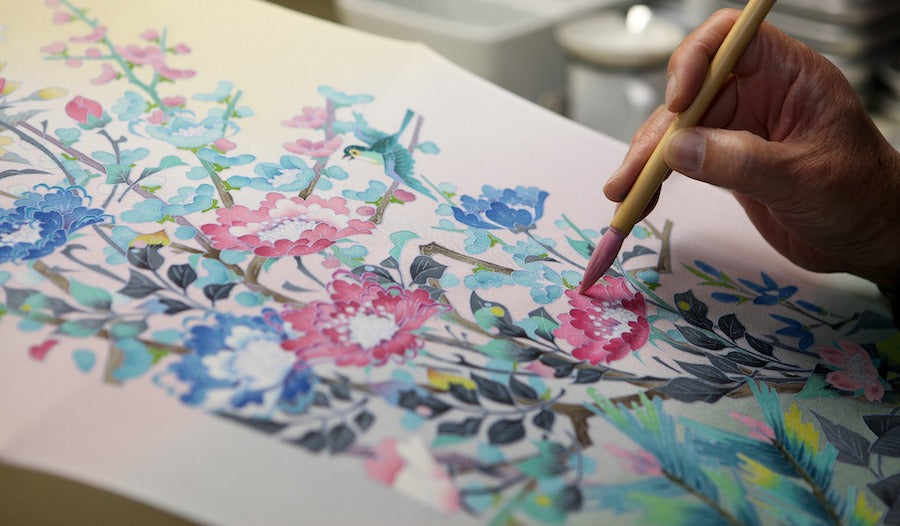
MASTER CRAFT
Image: Hitoshi Maida yuzen-dyeing. Courtesy of The Japan Foundation.
In Japan, yuzen-dyeing became the fashionable at the end of the 17th century. It is a paste resist-dyeing technique, used to create large, pictorial, freehand designs of many colours. The technique, now called hon-yuzen— true, or original yuzen —revolutionized kosode decoration. After the Meiji Restoration of 1868, yuzen created a new fashion among both the wealthy, and middle-class women, and went on to have a strong impact on kimono decoration in late 19th century Japan.
The style originates from the name of a popular fan designer in Kyoto, Miyazaki Yuzen. His designs were so popular, kimono makers and kimono design book publishers designated patterns in his style as the ‘yuzen-pattern’.
 Image: Yuzen-dyed kimono. Courtesy of The Japan Foundation.
Image: Yuzen-dyed kimono. Courtesy of The Japan Foundation.
Traditional yuzen-dyeing is a true handcraft. It is characterised by very fine outlines, called itome, made by squeezing rice starch paste (nori), by hand, from a cone onto the base fabric, which is usually silk. The paste contains glutinous rice powder, rice paste, rice bran and lime, but the ratio of ingredients is the secret of the craftsman. A liquid called gojiru, made from beans, is then brushed on to the outlined areas. This allows the dye to penetrate.
 Image: Hitoshi Maida yuzen-dyeing. Courtesy of The Japan Foundation.
Image: Hitoshi Maida yuzen-dyeing. Courtesy of The Japan Foundation.
The pattern areas are brush-dyed, often with a shading technique, bokashi-zome, to achieve subtle gradations in shades of colours. The patterned area of fabric is further resisted with additional rice starch paste, the background dyed by brush in a technique called hiki-zome. The whole is then steamed to set, and the fabric was washed in water to get rid of the starch paste. In the Finally, the fabric is smoothed with steam, to adjust the length and width, and may be embroidered.
This complex and traditional craft fell from grace as Japan rushed to Westernise its fabric manufacture. How wonderful, then, that some masters of the craft remain.
 Image: Hitoshi Maida. Courtesy of The Japan Foundation.
Image: Hitoshi Maida. Courtesy of The Japan Foundation.
Organised by The Japan Foundation, kaga yuzen artist, Hitoshi Maida, will be giving talks at a number of venues this month. He will be at Dovecot Studios, Edinburgh on Monday, 14 November; at the Jessop Building, Sheffield on Tuesday, 15 November; and at The Swedenborg Society, London on Wednesday, 16 November.
Our gratitude to Yuko Fukatsu-Fukuoka for the detail in this article.
